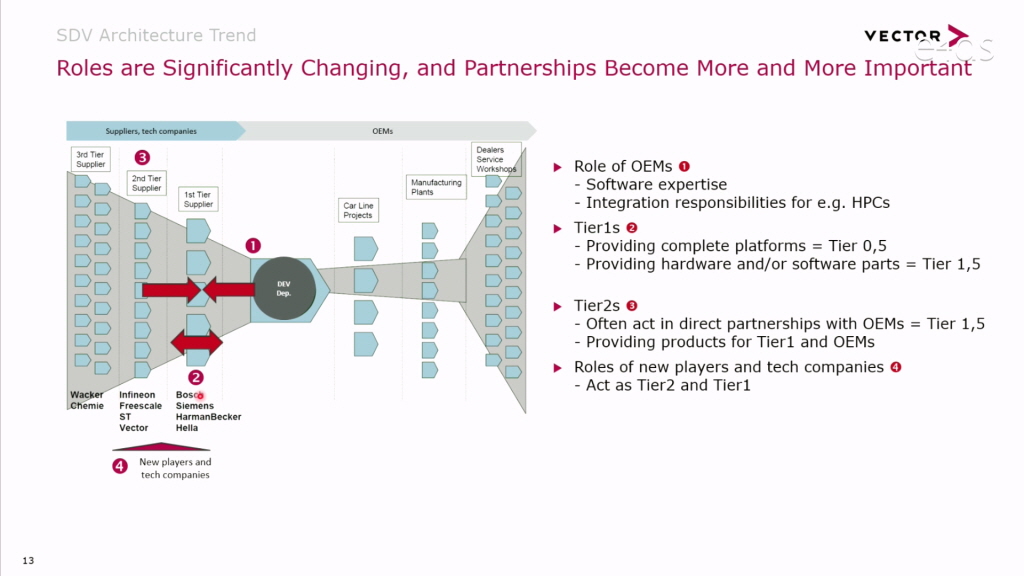소프트웨어 정의 차량(Software Defined Vehicle, SDV)가 이끄는 차량의 소프트웨어 중심으로의 패러다임과 아키텍처의 변화 속 핵심 성공 요소는 새로운 역할을 확립하는 파트너십과 긴밀한 협업이라는 전문가의 의견이 제기됐다.
.jpg)
▲김의열 벡터코리아 프로세스 솔루션 사업부장
Tier1, 플랫폼 공급 0.5 Tier·SW 혹은 HW 일부 납품 1.5Tier 역할 전망
Tier2, Tier1 거치지 않고 OEM과 파트너십 맺어 1.5Tier 가능성 제기
“아마존·구글·네이버 등 테크 기업, Tier1 혹은 Tier2처럼 활동할 수도”
소프트웨어 정의 차량(Software Defined Vehicle, SDV)가 이끄는 차량의 소프트웨어 중심으로의 패러다임과 아키텍처의 변화 속 핵심 성공 요소는 새로운 역할을 확립하는 파트너십과 긴밀한 협업이라는 전문가의 의견이 제기됐다.
김의열 벡터코리아 프로세스 솔루션 사업부 부장은 e4ds 웨비나에서 ‘SDV 아키텍처 최신 트렌드’를 주제로 발표하며 SDV 관련 개념과 특징, 개발 동향에 대해 설명했다.
이번 웨비나에서는 제조업에 상당한 영향을 끼치는 자동차 산업이 소프트웨어 중심으로 넘어가는 데에 따른 트렌드의 변화와 함께, SDV의 정의와 특징까지 알아볼 수 있도록 구성되었다.
김 사업부장은 “기존 스마트폰 사업은 카메라 화소 등에 의해 가격의 변동폭이 컸으나 소프트웨어와 다양한 산업군과 연결되어 있는 애플리케이션의 가치가 매우 중요해졌다”라며 “자동차 업계도 SDV 트렌드에 따라서 사업 모델들이 소프트웨어 중심으로 변화하고 있다”고 전했다.
그는 이어 “자동차 산업의 이러한 변화는 핸드폰 시장보다 크고 폭넓은 비즈니스 모델들을 만들어낼 것으로 예상된다”며 “선제적으로 대응하는 업체들은 성공적으로 발전할 것이고, 인지하지 못하는 업체들은 힘들어질 것”이라고 강조했다.
SDV(Software Defined Vehicle)는 고객에게 서비스를 통해 가치를 제공하는 것이 핵심이며 OTA를 통해 차량 출고 이후에도 클라우드를 통한 업데이트가 가능하며 최신 성능을 유지, 새로운 기능을 다운받아 사용할 수 있다.
안드로이드 오토나 독자적인 시스템과 같은 현재 기술은 Vehicle OS은 애플리케이션을 설치하고 업데이트하는 수준으로 인포테인먼트 앱(라디오, 내비게이션 등)으로 제한된다.
최종적으로는 인포테인먼트를 넘어 차량의 성능을 개선하고, 다른 산업군들과 맞물려 새로운 가치를 창출하는 방향으로 나아갈 것이며, 가까운 미래에는 자동차가 물류, 쇼핑, 레저와 같은 산업들과 연계뿐만 아니라 배터리, 토크 등의 성능을 개선하는 것까지 가능할 것으로 전망된다.
이를 구현하기 위해서는 복잡하고 정밀한 기능들을 빠르고 정확하게 처리할 수 있어야 하기에 코어의 개수를 늘리고, 병렬처리를 위한 멀티 쓰레드와 소프트웨어를 위한 가상 머신도 필요하다.
결국, 이러한 것들을 가능하게 하는 고성능 컴퓨터(HPC)가 필수적이다.
고성능 컴퓨터를 기반으로 하는 중앙 집중형 아키텍처, 빠른 데이터 전송을 위한 이더넷 통신 백본 구성, 클라우드와의 연결성 강화를 통한 외부 정보 수신 및 인터페이스 강화 등 기술적으로 복잡한 과제들을 해결해야 한다.
안전을 중시하는 자동차 산업의 긴 리드 타임을 단축하고 지속적인 업데이트가 가능한 개발 환경으로의 전환이 필요하다.
이러한 기술적 패러다임의 전환을 위해 아키텍처의 변화가 필수적이며, 이는 개발 조직, 프로세스 및 개발 툴체인의 변화가 필요하다는 것을 의미한다.
기존 차량 제어기들은 기능을 기반으로 아키텍처를 구성했으나, 미래에는 많은 기능들이 통합되고, HPC들을 기준으로 네트워크를 구성하게 된다.
복잡하고 빠른 연산을 수행하는 기능들은 컴퓨터에서, 단순한 센싱과 액츄에이션은 기존 제어기들에서 처리하게 된다.
이러한 변화는 기존 제어기들이 조금 더 단순해지고, HPC에서 구현되는 기능들의 크기와 복잡도가 올라간다는 것을 의미한다.
아키텍처 변화 트렌드에서 OEM과 서플라이어의 역할이 완전히 바뀐다.
 ▲SDV 아키텍처 최신 트렌드 e4ds 웨비나 中
▲SDV 아키텍처 최신 트렌드 e4ds 웨비나 中
OEM은 소프트웨어의 전문가로 활동하며 HPC의 통합에 대한 역할을 수행할 것이며, 기존 Tier1들은 완전한 플랫폼을 공급하는 0.5 Tier 역할을 하거나, 소프트웨어 혹은 하드웨어 일부를 납품하는 1.5 Tier의 역할을 맡을 것으로 보인다.
기존 Tier2는 Tier1을 거치지 않고, 바로 OEM과 파트너십을 맺으며 1.5Tier가 될 수도 있으며 새로운 플레이어인 아마존, 구글과 같은 테크 기업들이 Tier1이나 2처럼 활동할 것으로 내다보고 있다.
김 사업부장은 이러한 역할 변화에서 서로가 서로에게 배우고, 새로운 역할을 확립하는 파트너십이 SDV 트렌드의 핵심 성공 요소라고 강조했다.
김의열 사업부장은 OEM이 어떻게 변화할 것인가에 대해 설명하며 Illusion Phase을 언급하며 “Illusion Phase는 OEM들이 모든 소프트웨어와 OS를 자체 개발하고 Tier1은 없어도 된다라는 ‘환상’을 일컬으며, 이러한 환상이 깨지는 시기를 Phase of disillusionment라고 부른다”며 “모든 것을 자체 개발하고, 모든 소스 코드를 이해한다는 것은 불가능에 가까우며 폭스바겐 사례가 이를 뒷받침한다”며 폭스바겐이 소프트웨어 그룹인 CARIAD를 창립하고 모든 것들을 자체적으로 개발하려 했으나 실패와 구조조정을 겪은 이야기도 덧붙였다.
해외 OEM들과 서플라이어들은 오래전부터 SDV를 준비해왔고, 테크니컬 디테일을 논의하는 단계에 올랐으나 한국은 SDV의 정의와 방향성을 정하고 콘셉트를 개발하는 단계에 머물러 있으며 기술적인 측면에서 한국은 최소 2~3년 뒤쳐져 있다.
김의열 사업부장은 글로벌 업체와의 격차를 좁히기 위해서는 국내 업체들의 긴밀한 협업이 필요하다고 다시 한번 강조했다.
발표 후 이어진 Q&A에서 ‘복잡하지 않은 액츄에이터나 센서단에서는 SDV가 어떤 영향이 있고 어떤 것을 준비해야 하는지’에 대한 질문에 김의열 사업부장은 이들을 납품하던 업체나 Tier2는 앞으로 어려움이 있을 것이라고 솔직한 답변을 내놓았다.
그는 “많은 업체들이 고민하고 있는 것은 잘 알고 있다”며 “어려움을 겪을 것이라는 게 지배적인 전망이기에 사업 모델에 변화를 주어야 할 것으로 보인다”고 답했다.
※ 社告
지난 12월 8일 벡터코리아와 함께한 ‘SDV 아키텍처 최신 트렌드’를 시청해주신 여러분께 감사의 인사를 드립니다.
독자분들과 시청자분들이 주신 모든 질문에 답을 하고 싶었으나, 시간 관계 상 모든 답을 드릴 수 없었음을 양해 부탁드립니다.
많은 분들이 댓글로 남겨주셨던 보안 관련 질문들, 이외 다른 질문들을 정리하여 벡터코리아에 전달하였습니다.
시간이 조금 걸리더라도 기사를 통해 독자분들의 궁금증을 해결해드릴 수 있도록 하겠습니다.
다시 한번 e4ds 웨비나에 관심을 가져주신 분들께 감사드립니다.
.jpg)
